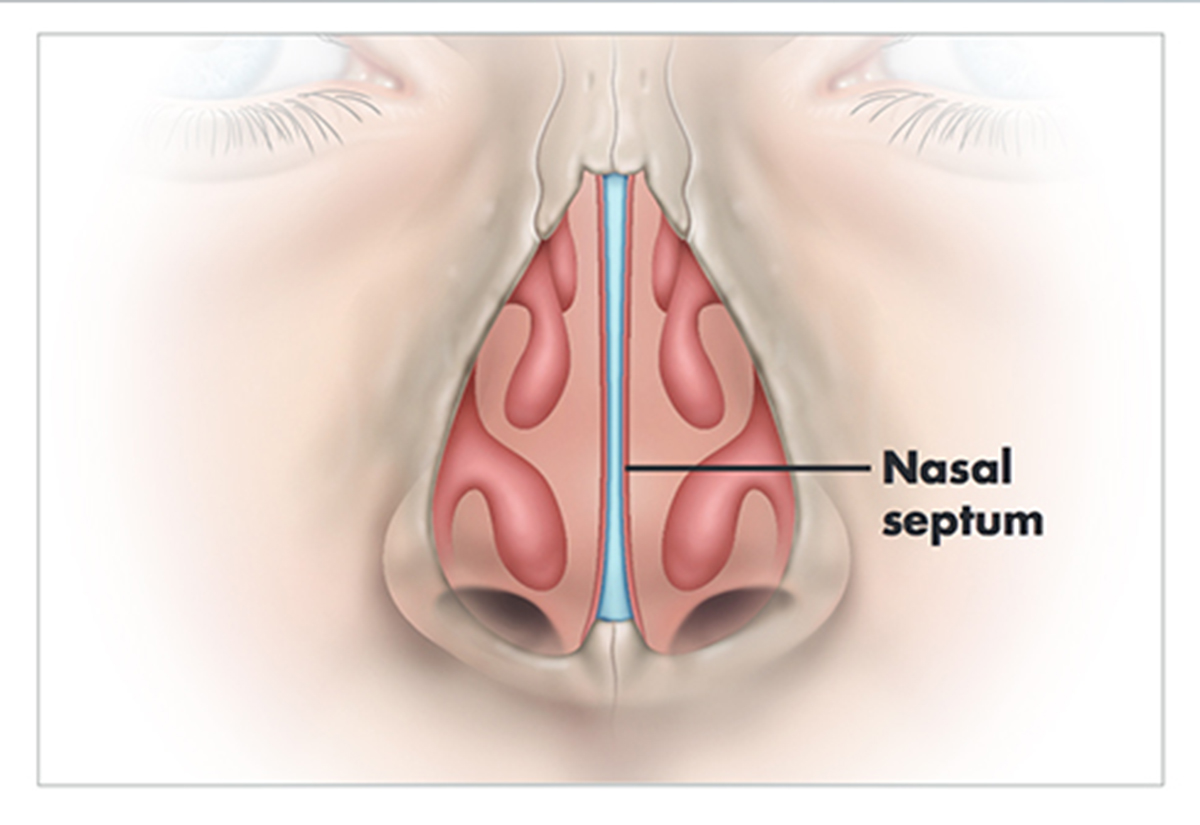The nasal septum is a thin wall that separates your right and left nasal passages; typically present from birth.
An anatomical structure consisting of rings-like muscles that act to restrict or restrict a passage or opening in the body, such as the pyloric sphincter (source: Gale Encyclopedia of Medicine).
Deviated septa may alter how air flows through your nose and sinuses, potentially leading to sinusitis or nosebleeds.
Structure
The nasal septum is a complex osseocartilaginous structure that divides the nose into two nasal passages. Although symmetrical septa are rare, some deviation of this structure is considered acceptable and considered normal.
The front part of a septum is constructed from cartilage while its upper portion consists of bone. Olfactory nerves run along both parts of the septum as well as through middle and lower turbinates to carry aroma signals to the brain.
The columella is the small bone area on either side of a nasal septum that lies along its lateral aspect. This area may either be completely straight, with no deviations at all, or feature something known as a spur, an overgrowth of bone and cartilage that affects airflow through your nose. Departures in septal deviation as well as changes to anatomy of lateral septum can significantly impede airflow through it.
Function
The nasal septum is a bony-cartilaginous structure that separates left and right nasal cavities. It is covered by mucoperichondrium anteriorly (covering quadrangular cartilage) and mucoperiosteum posteriorly (covering bony septum), with mucoperichondrium covering quadrangular cartilage anteriorly and mucoperiosteum covering bony structures posteriorly (including septal bone). It features perpendicular plates of ethmoid bone superiorly which extends down towards cribriform plate, and vomer bordering Choana; while its cartilage components include quadrangular, sphenoid bones as well as contributions from maxillary and palatine bones [2]
The septum receives blood supply from anterior and sphenoid arteries through Kisselbach’s plexus and greater Palatine Artery on its anteroinferior part, providing abundant blood. A common condition known as septal deviation occurs with wide variations in its prevalence – minor deviated septum may pass without symptoms whereas severe deviation may cause sinus blockage, headaches and impaired quality of life.
Symptoms
The nasal septum is the thin wall that separates your right and left nasal passages, but if this structure becomes misalign, it can interfere with breathing, leading to congestion or difficulty. Deviated septa may also increase sinus infections, nosebleeds or snoring symptoms – so if this applies to you it’s wise to seek medical advice immediately.
Healthcare providers use various approaches to diagnose deviated septums. First they will review your medical history and conduct a physical exam; they may use an instrument called a nasal speculum to painlessly spread open your nostrils so they can examine how the position of your septum affects its size and size of nasal passages; they’ll also ask about symptoms affecting daily life as part of this assessment process.
Diagnosis
Your doctor will conduct a physical exam of both the nose and ears to diagnose a deviated septum, using tools such as nasal speculum to open your nostrils and look inside, as well as using an otoscope (small, lighted scope) to inspect nasal and sinus passages. They may also examine the size and angle between nostrils as well as gather information regarding symptoms and medical history.
Most people don’t recognize they have a deviated septum until it starts causing symptoms, such as difficulty breathing through one side of their nose or one side of their face, frequent sinus infections or nosebleeds, sleep problems such as snoring or headaches and facial pain. While it can occur from birth itself or later due to trauma such as childbirth or injuries sustained later in life such as nose injuries – ultimately people only discover they have it once it begins manifesting symptoms like difficulty breathing through either nose.
Treatment
Minor deviations of the septum often go undetected and don’t present symptoms, while severe deviations can block one nostril and create nasal congestion, making your nose susceptible to sinus inflammation and nosebleeds, interfering with drainage, leading to repeated sinus infections, or interfering with drainage altogether.
Physicians can quickly check for deviated septa by observing their patient from behind and peering inside with bright lighting and sometimes using an instrument called a nasal speculum, which expands and spreads out nostrils to examine interior passageways.
Treatment options aim to alleviate symptoms by relieving their discomfort, including using steroid nasal sprays. Surgery called septoplasty has proven very successful at improving nasal breathing, decreasing sinus inflammation and controlling nosebleeds.
Disclaimer: The content on this blog is intended for general informational purposes only. It is not a substitute for professional medical advice, diagnosis, or treatment. Always consult qualified healthcare providers for personalized advice. Information regarding plastic surgery, dental treatment, hair transplant, and other medical procedures is educational and not a guarantee of results. We do not assume liability for actions taken based on blog content. Medical knowledge evolves; verify information and consult professionals. External links do not imply endorsement. By using this blog, you agree to these terms.










